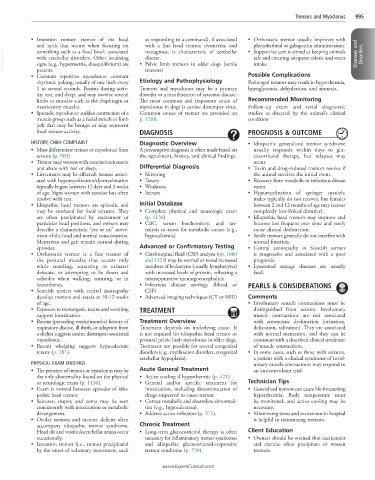Page 1987 - Cote clinical veterinary advisor dogs and cats 4th
P. 1987
Tremors and Myoclonus 995
• Intention tremor: tremor of the head as responding to a command), if associated • Orthostatic tremor usually improves with
phenobarbital or gabapentin administration.
and neck that occurs when focusing on with a fine head tremor, dysmetria, and • Supportive care is aimed at keeping animals
VetBooks.ir with cerebellar disorders. Other localizing • Pelvic limb tremors in older dogs (senile safe and ensuring adequate caloric and water Diseases and Disorders
something such as a food bowl; associated
nystagmus, is characteristic of cerebellar
disease.
intake.
signs (e.g., hypermetria, disequilibrium) are
present.
• Constant repetitive myoclonus: constant tremors) Possible Complications
rhythmic jerking, usually of one limb every Etiology and Pathophysiology Prolonged tremors may result in hyperthermia,
1 to several seconds. Persists during activ- Tremors and myoclonus may be a primary hypoglycemia, dehydration, and anorexia.
ity, rest, and sleep, and may involve several disorder or a manifestation of systemic disease.
limbs or muscles such as the diaphragm or The most common and important cause of Recommended Monitoring
masticatory muscles. myoclonus in dogs is canine distemper virus. Follow-up exam and serial diagnostic
• Sporadic myoclonus: sudden contraction of a Common causes of tremor are provided on studies as directed by the animal’s clinical
muscle group such as a facial twitch or limb p. 1288. condition
jerk that may be benign or may represent
focal seizure activity. DIAGNOSIS PROGNOSIS & OUTCOME
HISTORY, CHIEF COMPLAINT Diagnostic Overview • Idiopathic generalized tremor syndrome
• Must differentiate tremor or myoclonus from A presumptive diagnosis is often made based on usually responds within days to glu-
seizure (p. 903) the signalment, history, and clinical findings. cocorticoid therapy, but relapses may
• Tremor may worsen with exercise/excitement occur.
and abate with rest or sleep. Differential Diagnosis • Toxin and drug-induced tremors resolve if
• Littermates may be affected: tremor associ- • Shivering the animal survives the initial event.
ated with hypomyelination/dysmyelination • Tetany • Recovery from metabolic or infectious disease
typically begins between 12 days and 3 weeks • Weakness varies.
of age. Signs worsen with exercise but often • Seizure • Hypomyelination of springer spaniels:
resolve with rest. males typically do not recover, but females
• Idiopathic head tremors are episodic and Initial Database between 2 and 12 months of age may recover
may be confused for focal seizures. They • Complete physical and neurologic exam completely (sex-linked disorder).
are often precipitated by excitement or (p. 1136) • Idiopathic head tremors may improve and
particular head positions, and owners may • CBC, serum biochemistry, and uri- become less frequent over time and rarely
describe a characteristic “yes or no” move- nalysis to assess for metabolic causes (e.g., cause clinical dysfunction.
ment of the head and normal consciousness. hypocalcemia) • Senile tremors generally do not interfere with
Mentation and gait remain normal during normal function.
episodes. Advanced or Confirmatory Testing • Central axonopathy in Scottish terriers
• Orthostatic tremor is a fine tremor of • Cerebrospinal fluid (CSF) analysis (pp. 1080 is progressive and associated with a poor
the postural muscles that occurs only and 1323) may be normal or reveal increased prognosis.
while standing, squatting to urinate/ numbers of leukocytes (usually lymphocytes) • Lysosomal storage diseases are usually
defecate, or attempting to lie down and with increased levels of protein, reflecting a fatal.
subsides when walking, running, or in nonsuppurative meningoencephalitis.
recumbency. • Infectious disease serology (blood or PEARLS & CONSIDERATIONS
• Scottish terriers with central axonopathy CSF)
develop tremors and ataxia at 10-12 weeks • Advanced imaging techniques (CT or MRI) Comments
of age. • Involuntary muscle contractions must be
• Exposure to tremorgenic toxins and vomiting TREATMENT distinguished from seizure. Involuntary
support intoxication. muscle contractions are not associated
• Recent (preceding weeks/months) history of Treatment Overview with autonomic dysfunction (urination,
respiratory disease, ill thrift, or adoption from Treatment depends on underlying cause. It defecation, salivation). They are associated
a shelter suggests canine distemper-associated is not required for idiopathic head tremor or with normal mentation, and they can be
myoclonus. postural pelvic limb myoclonus in older dogs. consistent with a described clinical syndrome
• Recent whelping suggests hypocalcemic Treatment not possible for several congenital of muscle contractions.
tetany (p. 281). disorders (e.g., myelination disorders, congenital • In some cases, such as those with seizures,
cerebellar hypoplasia). a patient with a clinical syndrome of invol-
PHYSICAL EXAM FINDINGS untary muscle contractions may respond to
• The presence of tremors or myoclonus may be Acute General Treatment an anticonvulsant trial.
the only abnormality found on the physical • Active cooling if hyperthermic (p. 421)
or neurologic exam (p. 1136). • General and/or specific treatment for Technician Tips
• Exam is normal between episodes of idio- intoxication, including discontinuation of • Generalized tremors can cause life-threatening
pathic head tremor. drugs suspected to cause tremor. hyperthermia. Body temperature must
• Seizures, stupor, and coma may be seen • Correct metabolic and electrolyte abnormali- be monitored, and active cooling may be
concurrently with intoxication or metabolic ties (e.g., hypocalcemia). necessary.
derangement. • Address active infection (p. 271). • Minimizing stress and excitement in hospital
• Ocular tremors and menace deficits often is helpful in minimizing tremors.
accompany idiopathic tremor syndrome. Chronic Treatment
Head tilt and vestibulocerebellar ataxia occur • Long-term glucocorticoid therapy is often Client Education
occasionally. necessary for inflammatory tremor syndromes • Owners should be warned that excitement
• Intention tremor (i.e., tremor precipitated and idiopathic glucocorticoid-responsive and exercise often precipitate or worsen
by the onset of voluntary movement, such tremor syndrome (p. 530). tremors.
www.ExpertConsult.com

